Japan
Wood Products Prices
Dollar Exchange Rates of 25th
Mar
2025
Japan Yen 150.58
Reports From Japan
US tariff policy could
upend recovery in Japan
The Bank of Japan’s (BoJ) resolve to closely monitor the
possible impact of U.S. tariffs on Japan’s economy
prompted it to keep interest rates unchanged at 0.5% at its
most recent meeting. Analysts are split over when the
central bank’s next raise will be.
At a press conference following the bank’s Monetary
Policy Meeting, BoJ Governor, Kazuo Ueda, indicated the
effects of the high tariff policy of the U.S. administration
on Japan’s economy and consumer prices would need to
be carefully assessed.
The U.S. administration has proposed additional tariffs on
automobiles imported from all nations and regions. If this
plan goes ahead the business performance of Japanese
automakers could suffer and the Japanese economy could
come under downward pressure. Ueda said the higher U.S.
duties could also affect the Japanese economy through
their impact on the global economy or more directly
through supply chains.
Ueda also pointed out that “some data” suggested the
uncertainty was starting to affect consumer sentiment in
the United States. The governor indicated the bank would
analyse the risks to Japanese economic activity, including
the psychological impact on companies and household
spending.
See:https://japannews.yomiuri.co.jp/business/economy/20250320
-244355/
Another rate rise will get Japan back on track
The recent downward pressure on the yen has eased
slightly as Japan's policy rate has risen above that of
Switzerland's for the first time in two years. Many market
watchers expect the interest rate spread between Japan and
Switzerland to only grow further as the BoJ continues to
raise rates.
During a news conference following a two-day monetary
policy meeting that ended with the BoJ board deciding to
keep the un-collateralised overnight call rate unchanged
Governor Ueda left open the option for a rate hike in May
mentioning the risk of an upward swing in inflation and
vowing to "avoid falling behind the curve."
Economists were unanimous in projecting back-to-back
rate increases as unlikely from a BoJ intent on playing it
safe since roiling the markets last year with a surprise rate
increase.
The governor indicated the Bank would analyse the risks
to Japanese economic activity including the psychological
impact on Japanese companies and household finances.
Business confidence among Japanese manufacturers
– negative in March
In March business confidence among Japanese
manufacturers turned negative for the first time in three
months reflecting concerns over U.S. tariffs and a sluggish
Chinese economy according to a Reuters Tankan survey.
The manufacturers’ sentiment index fell the lowest level
since December. The non-manufacturer index also
weakened, as rising labour and transport costs weighed on
sentiment. Reuters Tankan is a monthly survey that seeks
to track the Bank of Japan's tankan quarterly survey.
See: https://www.forexlive.com/news/japan-business-sentiment-
weakens-in-march-amid-tariff-and-china-concerns-20250318/
China still a favourite with Japanese companies
According to the latest survey released by the Japanese
Chamber of Commerce and Industry in China more than
half of the Japanese companies operating in China and
surveyed said that they plan to either increase or maintain
their investment because China is their primary market.
The positive sentiment was driven by multiple factors
including growing demand and rising orders. Additionally,
other changes have fueled Japanese businesses' confidence
in the Chinese market such as an improved business
environment, a visa-free policy for Japanese citizens and
other government stimuli, including trade-in policies to
spur consumption.
See: https://www.globaltimes.cn/page/202502/1328323.shtml
Operations in the US an option but there are risks
According to a Nikkei survey nearly 50% of major
Japanese companies look to expand U.S. operations as the
US administration increases efforts to draw foreign
investment, though many remain worried about the
uncertainty surrounding his tariff plans.
Of the 144 companies that provided responses, 28% said
they plan to expand in the US with another 21%
considering doing so while others with no presence there
now aim to enter the market. None of those surveyed
intend to scale back US operations.
See: https://asia.nikkei.com/Business/Business-trends/Half-of-
top-Japan-business-leaders-eye-U.S.-expansion-survey
Households savings dropping fast
According to the BoJ Japanese households reduced their
savings at the fastest pace on record in the last quarter of
2024 as they struggled to cope with the rising cost of
living. Holdings of cash slipped to yen 105.3 trillion in the
three months ended in December, down 3.4% from a year
earlier in the biggest drop in the data going back to 1998.
The decline mostly likely reflects the wider adoption of
cashless consumption as well as a decline in nominal
consumer spending due to inflation, a reversal after the
pile of cash grew during the COVID-19 pandemic, the BoJ
said at a briefing.
The decline in cash comes as economists have been
watching to see if households change their behavior
regarding so-called mattress money, or funds kept at
home. A government report showed that in March Japan’s
inflation rose at a faster pace than expected, staying well
above BoJ’s 2% target.
See:
https://www.japantimes.co.jp/business/2025/03/21/economy/japa
n-households-slash-cash/
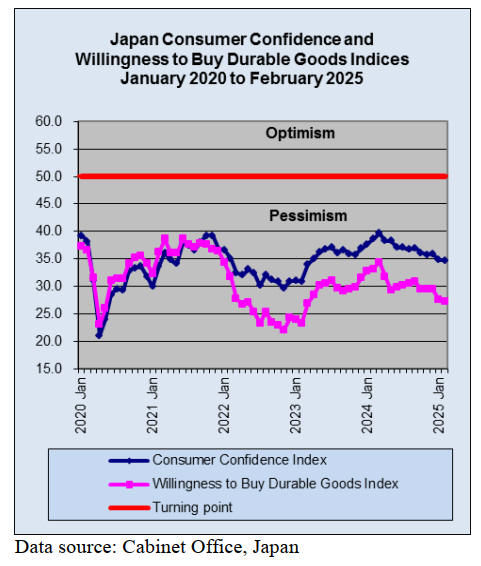
Yen exchange rate rattled by statements from the US
The yen strengthened against the dollar recently reaching
148 at one point but analysts expect the Japanese currency
to eventually weaken in light of the uncertain U.S.
economic outlook and divergence of Japan-U.S. monetary
policies.
The latest yen rally was sparked by comments from the
US that countries such as Japan and China were “driving
down their currencies which is unfair to the U.S.”.
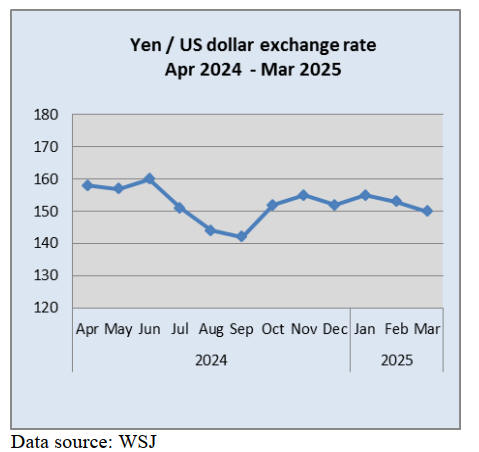
Japanese real estate attracts overseas investment
An Asia-based investment fund has indicated it is
considering investing about US$7 billion in Japanese real
estate over the next three years aiming to buy property
being sold by Japanese companies and to invest in data
centres.
See: https://asia.nikkei.com/Business/Markets/Property/Asia-
fund-PAG-to-invest-7bn-in-Japan-real-estate-over-3-years
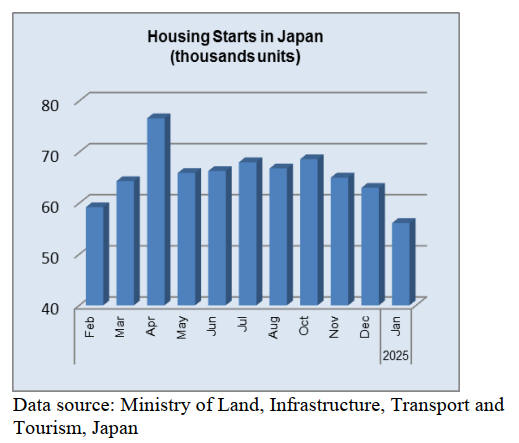
Import update
Yen value of furniture imports
Beginning in the third quarter of 2024 and extending to
January 2025 there has been a steady upward trend in the
value of furniture imports.
While some of the upswing can be explained by the
weaker yen making imports more expensive a review of
the quantity of imports as reported by Japanese Customs
reveals an steady increase in the quantity of wooden
furniture arriving in Japan.

January 2025 wooden office furniture imports (HS
940330)
In January 2025 as was the case in December 2024
shippers in China accounted for 93% of Japan’s imports of
wooden office furniture (HS 940330). The only other
shipper of note in January was Malaysia, which increased
market share to 2% (1.5% in December 2024). The third
and fourth ranked shippers in terms of value were
Indonesia and Italy.
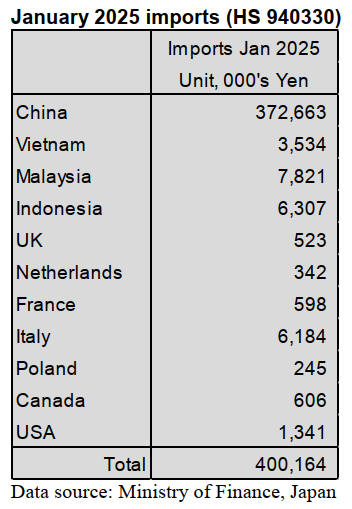
Year on year, the value of Japan’s imports of wooden
office furniture in January was little changed but month on
month there was a huge 40% rise in the value of arrivals.
January 2025 wooden kitchen furniture imports (HS
940340)
In January 2025 the combined value of shipments of
wooden kitchen furniture (HS 940340) from the
Philippines and Vietnam accounted for over 70% of
Japan’s imports of HS 940340.
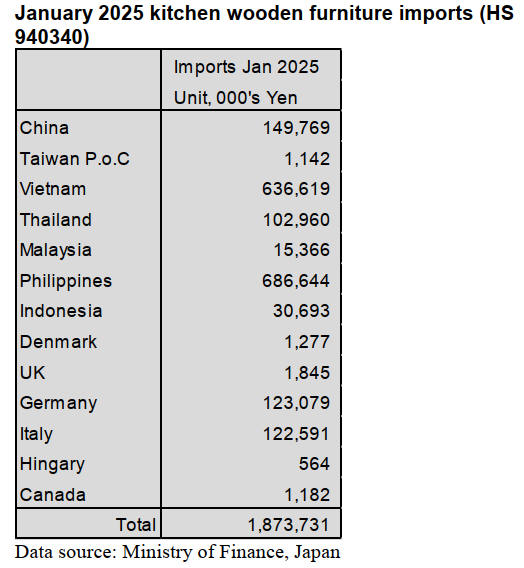
The Philippines and Vietnam each accounted for around
35%. of total imports of wooden kitchen furniture in
January this year. The other shippers of note in January
were China (8%) and Germany and Italy, with a combined
share of around 7%.
The year on year value of Japan’s wooden kitchen
furniture imports rose 42% in January further extending an
upward trend. Compared to the value of imports in
December a 38% rise was recorded in January.
January 2025 wooden bedroom furniture imports (HS
940350)
The top two shippers of wooden bedroom furniture (HS
940350) to Japan in January were China (57%) and
Vietnam (35%). Malaysia and Poland were the other
shippers of note in January with Malaysia, seeing a 6%
share of January imports (up from 3% in December).
Compared to December 2024 there was a 24% increase in
the value of imports in January and a 35% rise compared
to the value reported for January 2024. Over the past four
months there has been a steady upward trend in the value
of wooden bedroom furniture imports to Japan.
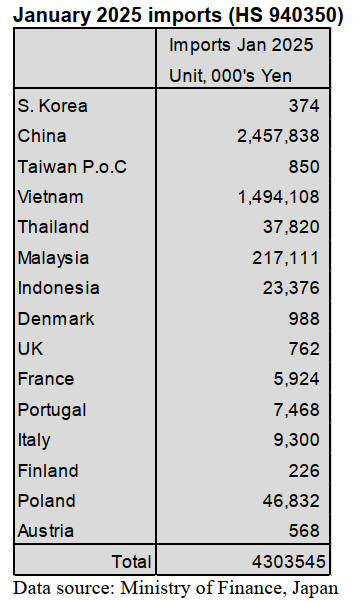 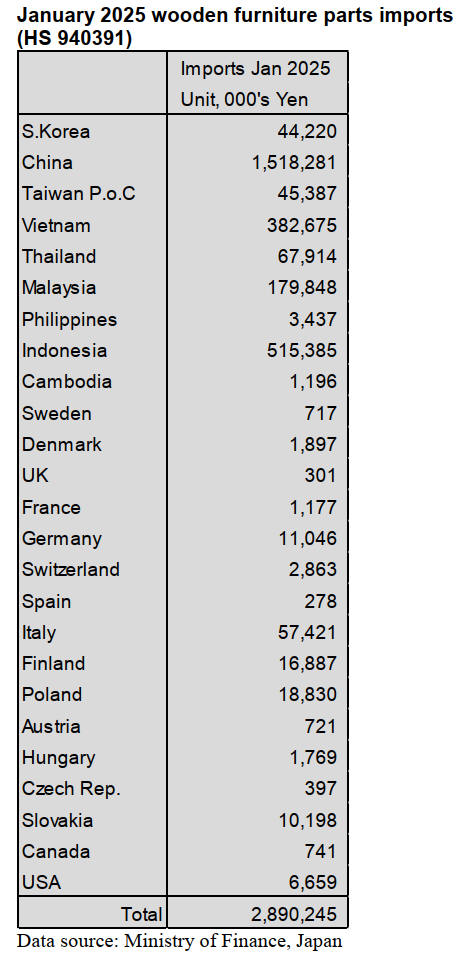
Shippers in China, Indonesia, Vietnam and Malaysia,
as in
previous months, accounted for around 90% of Japan’s
imports of wooden furniture parts (HS 940391) in January
2025.
Of the total value of imports, 57% was delivered from
China, almost the same value as in December 2024; 18%
from Indonesia, a slight rise month on month; 13% from
Vietnam and 6% from Malaysia, a slight drop month on
month.
Compared to the value of January 2024 imports there was
a sharp rise of 31% in the value ofJanuary 2025 imports
and a 35% increase compared to December 2024
Trade news from the Japan Lumber Reports (JLR)
The Japan Lumber Reports (JLR), a subscription trade
journal published every two weeks in English, is
generously allowing the ITTO Tropical Timber Market
Report to reproduce news on the Japanese market
precisely as it appears in the JLR.
For the JLR report please see:
https://jfpj.jp/japan_lumber_reports/
North American lumber import in 2024
Volume of North American log in 2024 is 1,476,240
cbms, 14.2 % less than 2023. This is straight two years for
not exceeding 2,000,000 cbms.
Volume of North American lumber is 939,000 cbms and
this is also straight two years for not exceeding 1,000,000
cbms. However, volume of SPF and Western Hemlock is
over 15 % more than last year so total volume is 6.7 %
more than 2023. Since Chugoku Lumber Co., Ltd. had a
fire at its plant, the company could not purchase a certain
amount of Doulgas fir logs. Also, there had been an
influence of low demand in Japan. Logs for major
Japanese lumber manufacturers from the US is 6.7 % less
and from Canada is nearly 30 % less than the previous
year.
As for North American lumber, volume of SPF is better
than last year because it was as a reaction to the inventory
control in 2023. Additionally, the starts of 2 x 4 in 2024
are 95,095 units, 4.7 % more than 2023 so the inquiries
rose.
The reason for a decrease in Douglas fir lumber is that
precutting plants hesitated to purchase the lumber due to
low demand for houses.
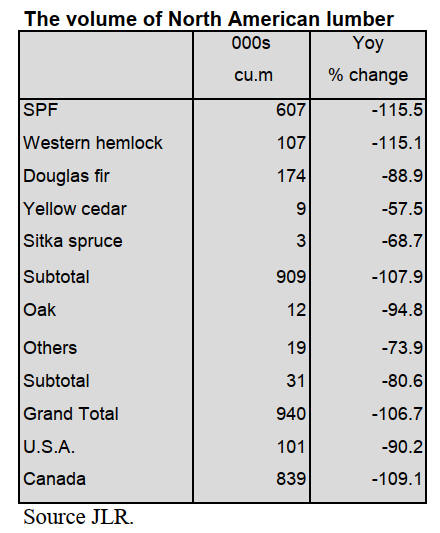
European softwood lumber import in 2024
Volume of softwood lumber from Europe in 2024 is
2,196,000 cbms, 32.9 % more than 2023. The volume in
2023 was under 2,000,000 cbms.
Softwood lumber supply increased even though the new
starts was 3.4 % less than the previous year. Especially, it
was an oversupply of whitewood stud at the second half of
2024. However, whitewood studs and whitewood lamina
were less popular than redwood studs and redwood lamina
because there had been an influence of the woodshock and
demand for whitewood studs or lamina shrank.
The log price will keep high this 2025 because the price of
whitewood log in Europe skyrocketed due to a shortage.
Planed or filed stud in 2024 is 779,682 cbms, 26.7 % more
than 2023. Lamina is 1,409,620 cbms, 36.9 % more than
last year. Tongue and groove is 7,345 cbms, 1.1 % more
than the previous year.
Pine lumber is 942,932 cbms, 38.9 % up. Fir, spruce and
other lumber are 466,688 cbms, 33.0 % up.
Softwood lumber from Romania, Czech and several
countries in Central Europe increases widely. On the other
hand, softwood lumber from Ukraine and Switzerland
decreases. The average import price of lamina in 2024 is
44,862 yen, 5.7 % more and of stud is 61,811 yen, 1.0 %
less than last year.
Plywood
Domestic plywood manufacturers raised the price of
softwood plywood in January and February, 2025. 12 mm
3 x 6 structural softwood plywood is 980 – 1,000 yen,
delivered per sheet. However, the plywood manufacturers
will raise the price by 1,100 yen, delivered per sheet, in
March, 2025 due to low profits.
Movement of domestic softwood plywood has been dull
since February, 2025 because the demand is low as usual.
The precutting plants say that a number of orders for a
house is poor. There are not enough plywood and logs at
several plants and the due date will be delayed. The
plywood production in February, 2025 is low due to less
working days.
Imported 12 mm South Sea plywood would be tight in this
spring because there had been heavy rains and floods
during the end of January to the beginning of February,
2025 in Sarawak, Malaysia. Plywood plants in this area
stopped operations and there were not enough logs.
The price of 12 mm plywood has been raised by $10 – 20,
C&F per cbm from the previous negotiation.
12 mm 3 x 6 painted plywood for concrete form is $590 –
600, C&F per cbm. Plywood form is $500 – 510, C&F per
cbm. Structural plywood is $510 – 520, C&F per cbm. 2.4
mm 3 x 6 plywood is $970, C&F per cbm. 3.7 mm 3 x 6
plywood is around $880, C&F per cbm. 5.2 mm 3 x 6
plywood is $850, C&F per cbm.
In Japan, the price of 12 mm plywood is 30 – 40 yen,
delivered per sheet, more than last month.
12 mm 3 x 6 painted plywood for concrete form is around
1,850 yen, delivered per sheet. Plywood form is 1,550 yen,
delivered per sheet. Structural plywood is 1,550 yen,
delivered per sheet. 2.5 mm plywood is 750 yen, delivered
per sheet. 4 mm plywood is 930 yen, delivered per sheet.
5.5 mm plywood is 1,100 yen, delivered per sheet.
Domestic lumber and logs
The production of lumber cannot keep up with the
inquiries at precutting plants. The prices of cedar studs,
cedar ceiling joists, 90 mm cypress squares or sills and
taruki have been increasing. As a result, there are not a lot
of lumber delivered from Kyushu region in Kanto region.
The precutting plants have been struggling with deficit
because the working days are less and they have to lower
the price of lumber for house builders. This is the reason
that the precutting plants changed to purchase domestic
lumber instead of imported lumber. Since distributors
forecasted that logs would be in short, they ordered a lot of
lumber to lumber manufacturers.
The price of KD 105 mm cedar post is 58,000 – 60,000
yen, delivered per cbm and this is 3,000 yen more than
January, 2025.
The prices of cedar and cypress logs are high because
there are not enough logs due to the heavy snow. Cypress
log for sill is 26,000 yen, delivered per cbm, in Okayama
Prefecture.
It is 25,000 yen, delivered per cbm in Kyushu region, is
24,600 yen, delivered per cbm in Shikoku region and is
24,500 yen, delivered per cbm in Tochigi Prefecture.
These prices are about 3,000 yen more than the previous
year.
The price of cedar log in Tochigi Prefecture is 17,000 yen,
delivered per cbm and this is the highest price in Japan.
This is 1,000 yen more than last year.
Supply of lumber is tight and the price of lumber is raised
in several places but the actual demand is low so it is
concerned that demand for domestic logs would drop. It is
important to see how the price of logs change after this
April.
Imported South Sea logs and lumber in 2024
Import of South Sea logs in 2024 is 36,186 cbms, 17.7 %
more than 2023. South Sea logs from Papua New Guinea
supposed to arrive to Japan at the second half of 2023 but
the South Sea logs arrived to Japan at the first half of 2024
so the volume of South Sea log from Papua New Guinea
increased widely in 2024. South Sea lumber is 6.8 % less
than 2023 and laminated boards are 1.6 % more than last
year.
The price of South Sea log in South Asia is still high but
some Japanese consumers purchase other kind of log
instead of South Sea log.
South Sea lumber from Indonesia is 46,164 cbms, 2.7 %
less and from Malaysia is 31,848 cbms, 8.4 % less than the
previous year. The reasons are low demand for houses in
Japan, high-priced lumber in South Asia and the weak yen.
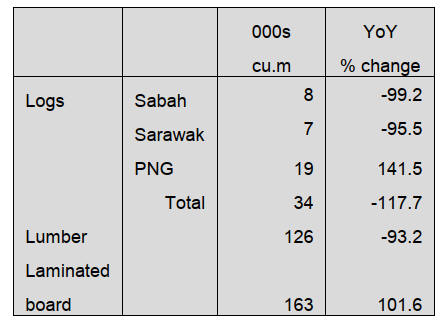
|